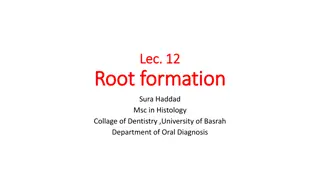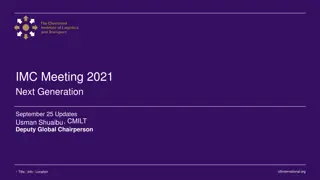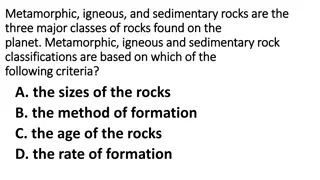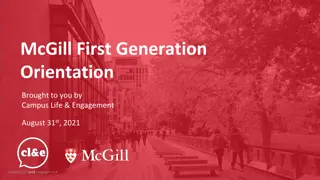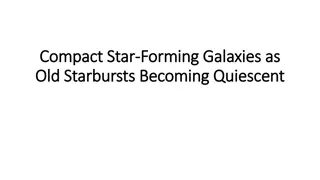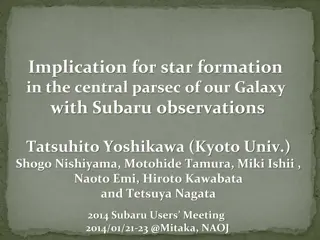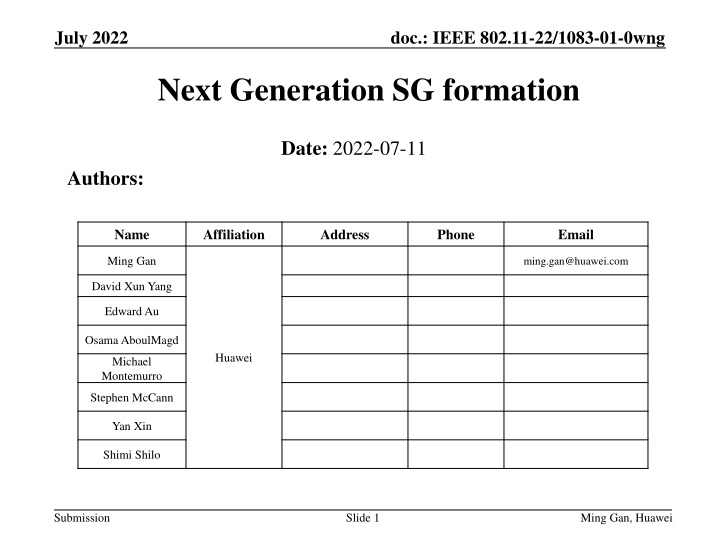
IEEE 802.11 Next Generation Study Group Formation Insights
Explore the considerations for the next major PHY/MAC amendment in the IEEE 802.11 standards focusing on enhancing throughput, latency, and operating bands like mmWave and sub-7 GHz. Learn about the objectives, challenges in wider bandwidth channels, and spectrum utilization for future enhancements.
Download Presentation

Please find below an Image/Link to download the presentation.
The content on the website is provided AS IS for your information and personal use only. It may not be sold, licensed, or shared on other websites without obtaining consent from the author. If you encounter any issues during the download, it is possible that the publisher has removed the file from their server.
You are allowed to download the files provided on this website for personal or commercial use, subject to the condition that they are used lawfully. All files are the property of their respective owners.
The content on the website is provided AS IS for your information and personal use only. It may not be sold, licensed, or shared on other websites without obtaining consent from the author.
E N D
Presentation Transcript
July 2022 doc.: IEEE 802.11-22/1083-01-0wng Next Generation SG formation Date: 2022-07-11 Authors: Name Affiliation Address Phone Email Ming Gan ming.gan@huawei.com David Xun Yang Edward Au Osama AboulMagd Huawei Michael Montemurro Stephen McCann Yan Xin Shimi Shilo Submission Slide 1 Ming Gan, Huawei
July 2022 doc.: IEEE 802.11-22/1083-01-0wng Introduction In the past 6 months, there are growing interest in considering the following features for the next major PHY/MAC amendment: New features, e.g., integration of mmwave and sub 7 GHz, ML/AI, enhanced range extension Features that had been discussed but not adopted in the current draft 802.11be standard, e.g., link adaptation (including HARQ), distributed RU, TSN, 16 spatial streams, wider channel in 6 GHz band, non-primary channel access, AP coordination (including two-hop range extension) It is expected that a Study Group will decide on the scope of work for the new amendment while preparing the PAR and CSD. In this contribution, we provide our consideration on the new amendment: Objectives: primarily focus on throughput and latency improvement Operating bands: consider both sub 7 GHz and above 45 GHz Submission Slide 2 Ming Gan, Huawei
July 2022 doc.: IEEE 802.11-22/1083-01-0wng Objectives Two common objectives being mentioned in various WNG SC contributions [1-13] are to further enhance the throughput and latency performance with respect to 802.11be. We propose that the objectives of the new amendment include at least the following: To further increase the aggregated throughput at both AP and STA (with multi-link operation) To improve the worst-case delay bound Submission Slide 3 Ming Gan, Huawei
July 2022 doc.: IEEE 802.11-22/1083-01-0wng Operating bands Significant throughput increment requires more frequency spectrum as mentioned in [1, 9, 10]. Two directions are provided in those contributions Wider bandwidth in the 6 GHz band Integrating mmwave (above 45 GHz) with sub 7 GHz by, e.g., reusing sub 7 GHz PHY These two directions are aligned to some extent, e.g., one PHY architecture and wide bandwidth. However, simply widening the bandwidth in the 6 GHz band cannot support throughput enhancement globally, due to the limited number of wider bandwidth channels the regulatory status of the 6 GHz band in some countries/regions Submission Slide 4 Ming Gan, Huawei
July 2022 doc.: IEEE 802.11-22/1083-01-0wng Operating bands: Number of wider bandwidth channels According to the channelization for 320 MHz in the 6 GHz band, 802.11be developed two types of 320 MHz due to the presence of extremely few 320 MHz channels UNII6 /7 80 UNII7 /8 80 160 UNII5 UNII6 UNII7 UNII8 80 80 80 80 80 80 80 80 80 80 80 80 160 160 160 160 160 160 320 320 320 320 320 320 It is hard to support a bandwidth wider than 320 MHz in the 6 GHz band with the following channel availability as examples. The limited configuration and availability of wider channels cannot bring sufficient value to throughput improvement. 2 x 480 MHz channels and 1 x 640 MHz channels in US 1 x 480 MHz Channels and 0 x 640 MHz channels in Europe 320 MHz, 480 MHz and 640 MHz are not available in China Moreover, the wider BW at 6 GHz will not be deployable because of not enough frequency reuse Slide 5 Submission Ming Gan, Huawei
July 2022 doc.: IEEE 802.11-22/1083-01-0wng Operating bands: Regulatory status of 6 GHz band assignment While there are growing number of countries and regions that allow WLAN to be used in the lower 6 GHz band, it is not certain for now when the entire 6 GHz band can be globally available for WLAN. In parallel, 3GPP is also considering the use of the 6 GHz band At the 3GPP RAN#96 plenary meeting held from June 6 to 9, 2022, 3GPP completed the standardization work of the upper 6 GHz spectrum (U6G, 6425 7125 MHz) as an IMT licensed band for NR, numbered n104, as part of Release 17. At this meeting, a resolution was also introduced regarding the continuation of the on-going efforts to also specify the entire 6 GHz band (5925 7125 MHz) for IMT as part of Release 18. Submission Slide 6 Ming Gan, Huawei
July 2022 doc.: IEEE 802.11-22/1083-01-0wng Operating bands: above 45 GHz IEEE 802.11 have published the 802.11ad and 802.11ay standards that utilize the unlicensed mmwave bands above 45 GHz There are concerns about the coverage and cost of 802.11ad and 802.11ay implementations. These concerns could be addressed by considering the multi-link framework and reusing the sub 7 GHz PHY We foresee that a multi-link device with both mmwave and low frequency bands is the future. The transmission range of such a multi-link device could be exactly the same as the existing WLAN device. mmwave can share the same PHY with sub 7 GHz instead of considering itself as an independent PHY. No extra complex work is expected to be required. Submission Slide 7 Ming Gan, Huawei
July 2022 doc.: IEEE 802.11-22/1083-01-0wng Operating bands: above 45 GHz While 802.11ad and 802.11ay consider 2.16 GHz as a minimum bandwidth, 3GPP for example, specifies 50 MHz, 100 MHz, 200 MHz and 400 MHz bandwidths in the 28 GHz band with 800 MHz spectrum. Its commercial products demonstrate that the corresponding hardware with these bandwidth configurations is mature We could have a few bandwidth configurations that are aligned with the sub 7 GHz PHY Given the mandatory support bandwidths in sub 7 GHz, 80 MHz is recommended as minimum bandwidth for above 45 GHz to reduce the cost. Wide bandwidth of 1 GHz and above could be implemented in high-end devices With a number of 80 MHz and 160 MHz channels above 45 GHz bands available, it would address the problem about high frequency reuse without a large bandwidth in enterprise/dense deployments [14] Submission Slide 8 Ming Gan, Huawei
July 2022 doc.: IEEE 802.11-22/1083-01-0wng Operating bands: above 45 GHz mmwave provides connectivity and reliable high throughput to devices that require wireless with limited mobility, e.g., AP coordination, wireless display and many other applications in the home/office/factory. Mobility could be maintained by considering the framework of multi-link with sub 7GHz In the following slides, we provide an emerging usage scenario that would require mmwave band Submission Slide 9 Ming Gan, Huawei
July 2022 doc.: IEEE 802.11-22/1083-01-0wng Emerging usage scenario for mmwave (1) In China, mobile operators are updating their service for its customers at home from FTTD (fiber to the door) to FTTR (fiber to the room) FTTR provides one WLAN network over all of the home, all smart devices access to the same network Each room has its own AP with a connection to the gateway by fiber, all APs forming one network Natural LOS: AP deployed in each room, penetration loss becomes negligible within this room Fiber infrastructure, with easy deployment, is able to provide more than 10 Gbps Interference mitigation becomes the key of this service for reliable high throughput Slave FTTR Slave FTTR fiber Master FTTR Slave FTTR 3 or more WLAN hotspots (all-optical WLAN) Submission Slide 10 Ming Gan, Huawei
July 2022 doc.: IEEE 802.11-22/1083-01-0wng Emerging usage scenario for mmwave (2) Mmwave becomes a very promising band for this FTTR service, since its transmission range is short and the OBSS interference could be significantly reduced (the penetration losses of walls of each room can be high). Pain points of the Multi-AP solution With mmwave of Interference mitigation AP1 AP1 Sometimes, two rooms are close to each other, but a single AP cannot cover the two rooms. In this case, interference exists between the two APs. As a result, the air interface bandwidth usage between STA1 and STA2 is low. STA1 After interference mitigation: The bandwidth between AP1 and AP2 is not affected, and AP1 and AP2 use the air interface independently . STA1 AP2 AP2 STA2 STA2 mmwave can mitigate interference from a different room while providing high throughput in a LOS environment within one room Mobility/roaming within the home can also be supported well with help from the sub 7 GHz connection in this network Slide 11 Submission Ming Gan, Huawei
July 2022 doc.: IEEE 802.11-22/1083-01-0wng Emerging usage scenario for mmwave (2) FTTR provides one WLAN network over all of the home, all smart devices access to the same network Each room has its own AP with a connection to the gateway by fiber, all APs forming one network Natural LOS: AP deployed in each room, penetration loss becomes negligible within this room Fiber infrastructure, with easy deployment, is able to provide more than 10 Gbps mmwave can mitigate interference from a different room while providing high throughput in a LOS environment within one room Mobility/roaming within the home can also be supported well with help from the sub 7 GHz connection in this network Slave FTTR Slave FTTR fiber Master FTTR Slave FTTR 3 or more WLAN hotspots (all-optical WLAN) Submission Slide 12 Ming Gan, Huawei
July 2022 doc.: IEEE 802.11-22/1083-01-0wng Emerging usage scenario for mmwave (1) In China, mobile operators are updating their service for its customers at home from FTTD (fiber to the door) to FTTR (fiber to the room) Interference mitigation becomes the key of this service for reliable high throughput mmwave becomes a very promising band for this FTTR service, since its transmission range is short and the OBSS interference could be significantly reduced (the penetration losses of walls of each room can be high). Pain points of the Multi-AP solution With mmwave of Interference mitigation AP1 AP1 Sometimes, two rooms are close to each other, but a single AP cannot cover the two rooms. In this case, interference exists between the two APs. As a result, the air interface bandwidth usage between STA1 and STA2 is low. STA1 After interference mitigation: The bandwidth between AP1 and AP2 is not affected, and AP1 and AP2 use the air interface independently . STA1 AP2 AP2 STA2 STA2 Submission Slide 13 Ming Gan, Huawei
July 2022 doc.: IEEE 802.11-22/1083-01-0wng Summary In this contribution, we provide our consideration on the next major MAC/PHY amendment in 802.11: Objectives: primarily focus on throughput and latency improvement Operating bands: consider both sub 7 GHz and above 45 GHz Submission Slide 14 Ming Gan, Huawei
July 2022 doc.: IEEE 802.11-22/1083-01-0wng Straw poll Do you agree to form a UHRT (Ultra High Reliability and Throughput) SG to develop a Project Authorization Request (PAR) and a Criteria for Standards Development (CSD) for a new 802.11 amendment with frequency bands between 1 GHz and 7.25 GHz and above 45 GHz and the following primary objectives: increase aggregated throughput improve worst-case delay bound Submission Slide 15 Ming Gan, Huawei
July 2022 doc.: IEEE 802.11-22/1083-01-0wng References [1] 11-22-0030-01-0wng-look-ahead-to-next-generation [2] 11-22-0032-00-0wng-next-gen-after-11be [3] 11-22-0046-01-0wng-next-generation-after-802-11be [4] 11-22-0059-00-0wng-beyond-be [5] 11-22-0418-00-0wng-considerations-of-next-generation-beyond-11be [6] 11-22-0458-01-0wng-looking-ahead-to-next-generation-follow-up [7] 11-22-0779-00-0wng-802-11bx-enabling-metaverse-metaverse-ar-vr-and-wearables [8] 11-22-0723-00-0wng-further-discussion-on-next-generation-wlan [9] 11-22-0729-01-0wng-next-generation-after-802-11be-follow-up [10] 11-22-0734-00-0wng-next-gen-after-11be-v2 [11] 11-22-0708-00-0wng-beyond-be-next-step [12] 11-22-0694-00-0wng-thoughts-on-next-gen-wlan [13] 11-22-0685-00-0wng-discussion-on-next-generation-wi-fi [14] 11-21-1536-00-0000-some-observations-on-optimizing-802-11be-release-1-with-respect-to- enterprise-ap-use-cases Submission Slide 16 Ming Gan, Huawei







